The Environmental Stewardship System (ESS): a generic system for assuring rural environmental performance
M. Andrew A I , T. Jarvis A , B. Howard B , G. McLeod C D , S. Robinson C E , R. Standen F , D. Toohey G and A. Williams HA URS Sustainable Development, 25 North Terrace, Hackney, SA 5069, Australia.
B URS Sustainable Development, L3, Hyatt Centre, 20 Terrace Road, East Perth, WA 6004, Australia.
C Murray–Darling Basin Commission, Irrigation Program, 15 Moore Street, Canberra, ACT 2601, Australia.
D Present address: G. D. McLeod, PO Box 160, Finley, NSW 2713, Australia.
E Present address: CRC for Greenhouse Gas Technologies, GPO Box 463, Canberra, ACT 2601, Australia.
F RMCG, PO Box 2410, Mail Centre, Bendigo, Vic. 3550, Australia.
G Dennis E Toohey & Associates, 659 Young Street, Albury, NSW 2640, Australia.
H Australia Cotton Growers Research Association, ‘Kia-Ora’, Narrabri, NSW 2390, Australia.
I Corresponding author. Email: martin_andrew@urscorp.com
Australian Journal of Experimental Agriculture 47(3) 245-259 https://doi.org/10.1071/EA06025
Submitted: 23 January 2006 Accepted: 6 November 2006 Published: 12 February 2007
Abstract
The Environmental Stewardship System (ESS) is proposed as a generic assurance system for demonstrating environmental performance. It incorporates Environmental Management Systems (EMS) and is matched to natural resources management (NRM) and catchment targets. ESS is a framework for aligning and clarifying environmental objectives and targets across scales. It operates at the catchment and farm levels, interdependently, focusing on the main industries, mainstream farming methods and whole-farm business management. For farmers, it provides a staged pathway of increasing levels of performance and audit process that they can progress along, up to full ISO 14001. It is a modular system that is expandable to suit the particular operational needs of land managers, industries and catchment agencies. ESS is an inclusive framework for integrating various industry farm management improvement schemes and other management requirements. It is an auditable system to provide recognition to land managers who deliver environmental stewardship. The ESS was developed from the findings of the Murray–Darling Basin Commission’s Watermark Environmental Stewardship Project. By addressing the four major deficiencies in current arrangements for NRM delivery (the Stewardship Standard is poorly defined at the Murray–Darling Basin and at the local scales; reporting of outcomes is poorly aligned across scales; and auditing arrangements are not integrated) ESS has the potential to significantly improve the delivery of NRM within Australia, when the drivers for uptake are strong enough. In particular, it would reinforce and elaborate the Australian regional NRM delivery model at the subregional scale. The ESS provides a national framework for assured agricultural production and rural land management. It is in the public domain for others to draw from or adopt.
Acknowledgements
The ESProj was a collective effort of many others besides the authors. The ESProj was possible because of the leadership by key people, many associated with the Trial Committees, who helped plan the project and who contributed to its development. Whilst there are many, the following industry people made particularly significant contributions: Maurice Incerti, Ian Cobbledick and Russell Pell (Dairy Trial), Guy Roth and Bruce Pyke (Cotton), Arun Tiwari, John Laurie and Peter O'Connor (Rice), and Rob Giles and Keith Jones (Vines). The trial participant farmers worked through the implementation of the ESProj processes, and provided the fundamental findings that underpin this report. Valuable guidance was provided by the ESProj Advisory Committee: Scott Keyworth (Director, Strategy Implementation, MDBC), Bruce Lloyd (National Landcare Council), Leigh Sparrow (Horticulture Australia), Andrew Rouse (Worldwide Fund for Nature; it was a comment by Andrew that led to us separating the environmental performance and process dimensions as orthogonal axes in Fig. 2), Jamie McMaster (Outsourced Environmental) and Lesley Rogers (DAFF – National EMS Pilot Program) who provided valuable comments on the draft final report. The planning stages of ESProj were led by our URS colleagues: John Fargher, David Marston and Stephanie Goldfinch. The authors are grateful for the comments of three anonymous referees, which helped strengthen this paper.
Hughey KDF,
Tait SV, O’Connell MJ
(2005) Qualitative evaluation of three ‘environmental management systems’ in the New Zealand wine industry. Journal of Cleaner Production 13, 1175–1187.
| Crossref | GoogleScholarGoogle Scholar |
(verified 14 December 2006)
Tee E,
Boland A-M, Medhurst A
(2007) Voluntary adoption of Environmental Management Systems in the Australian wine and grape industry depends on understanding stakeholder objectives and drivers. Australian Journal of Experimental Agriculture 47, 273–283.
| Crossref | GoogleScholarGoogle Scholar |
(verified 14 December 2006)
1 Catchment BMP is the level of management practice for an issue which, if adopted by the majority of land managers, would achieve the catchment targets. See Appendix on p. 255.
2 We use the term CMA to mean the regional catchment/natural resources management authority. These authorities have different acronyms in the different states.
3 The ‘ownership’ of ESS is an open question. Although ESS was developed as part of the MDBC’s Strategic Investigations and Education program, the MDBC’s charter is not consistent with it ‘owning’ the ESS for the purposes of implementing the ESS nationally, including the associated accreditation, certification and labelling systems.
Appendix: Description of the Environmental Stewardship Project
Objectives
The specific objectives of Environmental Stewardship Project (ESProj) were to:
-
improve understanding of the linkages between catchment-scale targets and on-farm practices, in relation to natural resource management (NRM);
-
develop draft performance standards for irrigation in the Murray–Darling Basin, incorporating lessons learned from regional farm trials;
-
create a practical process for environmental stewardship that land managers can adopt, through commercial scale farm trials;
-
provide information that will enable individual land managers to determine the most cost-effective level for them to target in adopting the principles of environmental stewardship; and
-
understand whether a continuous improvement system, benchmarked to the achievement of NRM targets, represents a cost-effective and efficient way to deliver both public NRM outcomes, and benefits at the enterprise level.
Planning
Two planning projects preceded ESProj. Stage 1 investigated the feasibility and benefits of the concept of using an EMS process matched to catchment targets to improve environmental performance, which concluded that it was worth proceeding (URS and CSIRO Land & Water 2000). Stage 2 determined a process, detailed proposal, budget and timetable for implementing the Stage 3 learning-by-trialing phase (i.e. ESProj) (URS 2002). The total duration of ESProj was some six years, including Stages 1 & 2.
Methods
Project and trial structure
A prototype ESS (described below) was trialed in four contrasting irrigated contexts: dairy in northern Victoria, rice-based systems at Coleambally, vines at Langhorne Creek and cotton in the northern Murray–Darling Basin. These trials are reported respectively in RMCG (2005), URS (2005b), URS (2005c) and Williams (2005). The trials were both stand-alone projects that would deliver value to the local stakeholders, as well as being the ‘living laboratories’ for testing the ESProj processes. These trials were selected to cover the main users of irrigation water across the Basin, and locations where there were strong industry partnerships. The trials incorporated similarities and differences that increased the findings from ESProj (summarised in Table A1).
Participant farmers were selected from volunteers by local trial industry hosts, as far as possible to obtain a cross-section of farm business types. By the end of the project, there were a total of 55 farmers involved, from 52 farm businesses (Table A1). The farmers covered a wide range of demographics, motivations for their participation and financial circumstances.
The trials were integrated into the overarching ESProj project, as illustrated in Fig. A1. The ESProj management team included the facilitator for each trial, as well as the key MDBC staff. The ESProj management team members are the authors of this paper.
ESProj logical process
ESProj began by building on the planning projects to finalise the prototype system to be trialed (the pathway of increasing environmental performance and audit process, and the protocols to underpin this), developing the project evaluation process, and initiating the regional trials.
The logic of the ESProj is summarised in Fig. A2. Each regional trial adapted the prototype system to suit local circumstances, developed their local Stewardship Standard (StewStd), and inducted their volunteer farmers, who implemented the local prototype on their own farms with close support from the trial’s project officer. At the end of each trial, the implementation and performance of each farmer’s system was externally reviewed against the prototype standards. Each trial concluded with a participatory benefit–cost analysis and evaluation.
In the final year, the ESProj management team developed the proposed comprehensive system for environmental stewardship, based on the prototype and informed by the findings from the regional trials. The draft ESS was road-tested and successively refined via presentations to stakeholder groups across the Basin.
Prototype Environmental Stewardship System
The prototype ESS used as the initial basis for the regional trials comprised a staged pathway of levels of performance and process, and the associated processes to operationalise the prototype: risk assessment; identification of priority issues and translating them into on-farm performance standards; and review/audit. The prototype involved risk assessment at catchment scale and industry scale, to identify the regional priority issues; risk assessment at farm-scale to identify the significant issues for that farm; setting performance standards matched to catchment and other environmental targets; and utilising the EMS continuous improvement cycle to ensure ongoing review of the adequacy of these elements of the system. The prototype and the key processes are outlined below.
The prototype ESS pathway
The prototype pathway comprised successive levels of environmental performance and assurance (audit) process along which participants could progress, starting from their current level of performance through to a production system at the highest level of environmental stewardship (full ISO14001). This was developed by resolving EMS into process (audit) and content (environmental performance), and deconstructing continuous improvement into its elements, to form a logical staged pathway of accessible steps up to full ISO 14001 (Fig. A3).
Risk assessment
The process for undertaking both regional and farm-level environmental risk assessments was the standard four-step environmental risk assessment methodology combined with the scoring elements of the AS/NZS 4360:1999 Risk Management standard. These are (1) hazard identification; (2) hazard assessment; (3) consequence assessment; (4) likelihood analysis; and (5) risk analysis. Three of the trials made modifications to the generic risk assessment methodology: the Cotton Trial used a checklist-based self-assessment process via the Cotton BMP Manual; Vines used the Cooperative Research Centre for Viticulture’s VERA risk assessment tool (Boland and Baker 2003); and Rice adopted the spirit rather than the letter of the methodology, because performance standards had not been developed due to delays experienced in that trial.
Prototype Local Stewardship Standard
The key environmental and other requirements of the CMA, government agencies and industry relevant to the trial were identified, collated and conflicts resolved as far as possible.
Regional priority issues and farm significant issues
The priority issues for each trial region were determined via a regional risk assessment, informed by the priority issues in the catchment plans. The significant issues for each farm were determined from a whole-farm risk assessment, which took into consideration the specific setting and location of the particular farm. Farmers were required to consider each of the trial-identified priority issues, but their final list of significant issues did not have to include a trial-identified issue if it was not significant for that farm, and included any other issues that were significant.
On-farm performance standards
The core of the on-farm performance standards was the catchment BMP: that level of management practice for an issue, which, if adopted by the majority of land managers, would achieve the catchment targets for the issues addressed by catchment BMP. The catchment BMP incorporated industry practices, along with those required to achieve NRM and catchment targets. It was developed by working back from the catchment plan targets for each of the trial priority issues, via expert teams drawn from NRM agencies, industry, irrigation companies, farmers and technical specialists who drew on their experience, expert judgement, ‘mental modelling’ and common sense. As well as catchment BMPs, trials variously recognised lesser performance standards (‘outmoded’, ‘legal requirements’, ‘minimum acceptable’ and ‘industry BMP’) that farmers could use as steps to performing at the catchment BMP standard. As part of the development process, each trial undertook a review of the usefulness of their catchment plans for deriving performance standards.
Action plan
The significant issues were addressed via an action plan developed for each farm.
Review and audit
Each farmer’s assessment of their environmental risks, identification of the significant issues requiring management, and their resulting action plan, were checked by an external advisory review. Reviewers were external to each farm, either from the trial stakeholder group [the Project Officer (Cotton, Dairy, Vines)], or an experienced government agency professional (Rice). These reviews were conducted with the farmer and usually involved an inspection of the farm. They not only provided an external assessment of the farmer’s planning, but also provided advice to the farmer as to how the action plan should be modified to achieve the farmer’s stated goals.
Monitoring and evaluation
The ESProj management team closely monitored and reviewed the prototype as it was developed by each trial and the testing of it by the trial farmers. The project was guided by an advisory committee of senior industry, government and non-government organisation people, who met with the ESProj management team and trial managers annually to evaluate progress and guide the project.
ESProj concluded with a participatory evaluation and a comprehensive benefit–cost analysis that probed the strength of the drivers for farmers to use ESProj or ESS to deliver priority environmental outcomes. This was based on a comprehensive questionnaire that each farmer was invited to fill out in a workshop format (URS 2005d). All these processes provided valuable findings.
The ESProj trials’ journeys
Changing national context
Adverse seasonal conditions
The project coincided with one of the worst droughts on record across all of eastern Australia. Water for irrigation became scarce, forcing some participants to suspend their normal farming practices. This, in turn, challenged farm finances and forced participants and processors to focus more on immediate survival rather than their trial. The conditions experienced during the project were very different to the conditions prevailing during the planning stages.
Policy initiatives
The period of the trial witnessed some major policy initiatives, including the regional model for NRM delivery [National Action Plan for Salinity and Water Quality (NAP) and the Natural Heritage Trust Stage 2 (NHT2), NRMSC 2002], water being traded into more profitable enterprises, the start of a major redirection of water from irrigated agriculture to environmental flows via ‘The Living Murray’, and culminated with the National Water Initiative in 2004.
Related industry initiatives and agendas
Many other initiatives co-occurred with the ESProj and its trials, interactions with which generated findings from each trial. The most significant of these were the EMS National Pilot Program and the National Pathways to Industry EMS Program (for more information on these, visit http://www.daff.gov.au/natural-resources/land-salinity/ems, verified 14 December 2006).
Implementing the prototype ESS
The farmers implemented the above processes on their own farms, assisted by their local trial personnel. All except the Cotton Trial farmers were each colocated in a single subregion and operated as a trial group, with regular meetings for training, review and discussion, and mutual support. The Cotton Trial farmers were very widely dispersed from central NSW to central Queensland, and were assisted on a one-on-one basis by cotton industry personnel.
Trial journeys
The cotton trial (Williams 2005) achieved its primary aim of expanding the cotton BMP (Williams and Williams 2000) to include a land and water management module. A challenge was the relatively early stage of development of the regional catchment plans in the northern Basin, and incompatibilities in detail between catchment plans, and especially between the Queensland and NSW jurisdictions. A major product of the trial was a comprehensive analysis of those regional catchment plans.
The dairy trial (RMCG 2005) was centred on strong group processes, and connected closely to the Goulburn–Broken Catchment Management Authority. Its progress was stymied by the consequences of the drought for the milk processors, who had to focus on maintaining supply rather than exploring how to incorporate environmental performance standards into the factory quality assurance requirements (this was to have been a major focus of the trial).
The major preoccupation for the first 18 months of the rice trial (URS 2005b) was to harmonise with the rice industry’s Environmental Champions Program (EC; described at www.rga.org.au/environment/champions.asp, verified 14 December 2006). This held up the progress of the rice trial. Eventually it was realised that the two programs were complementary rather than compatible, despite their superficial similarities. The program logics were quite different and ESProj was focused on sustaining the environment, whereas EC was focused on sustaining the rice industry (for which sustaining the environment is an important component). The drought and shortage of water made this difference more stark. In the final 18 months, the rice trial proceeded to implement the levels 1–4 of the ESProj with a renewed focus on Coleambally Irrigation’s need to comply with the requirements of renewing its irrigation licence.
The vine trial (URS 2005c) largely proceeded to plan, and was not too affected by drought because there was little reduction in the availability of irrigation water. Like the dairy trial, it was run as a group process (but without the farm walks), and it enjoyed strong support from most of its stakeholder partners. There was strong interest in the trial from other wine growing areas, and the trial helped shape the planning for Australian Wine Industry Stewardship, the wine industry’s Pathways to Industry EMS Program project. There was close liaison between the vine trial and the CRC Viticulture and the Mt Lofty Ranges EMS National Pilot Program Pilot.
Priority issues for environmental management
Out of a total of 24 priority issues collectively identified by the trials, only five issues (21%) were common to all trials (irrigation water management for water use efficiency, off-farm drainage, groundwater protection, native vegetation and biodiversity, and providing information about sustainable property management). Eight issues were common to three trials, seven to two trials, and four were issues for a single trial only. This illustrates what is expected, that while there is considerable overlap between the trial priority issues, each subregion and industry combination has a unique combination of subsets of the priority issues, and specific management practices are required to achieve the local catchment targets (the catchment BMPs). The implication of this is that there cannot be a single, comprehensive StewStd that applies at the Basin, catchment and local scales – the details have to be locally specific, despite some common water-management-related issues.
Analysis of catchment plan targets
The trials’ analyses of catchment plan targets relevant to the trial industries (Table A2) revealed that:
-
The issues are broadly similar across the catchments, because they conform to the broad National NRM Outcomes (NRMSC 2002). Issues differ in detail between the catchment plans, reflecting the different biophysical settings and industry mixes.
-
Many targets in the northern catchment strategies are not directly translatable to on-farm actions because they are more generic, written as actions for the agencies to undertake. Typical examples of actions include: ‘negotiate with industry’; ‘monitor the performance of promoted practices’; ‘document relevant case studies’; ‘identify areas of high risk’; ‘provide incentives …’; and ‘develop an environmental benefits index …’. This reflects the more recent development of regional catchment planning in this region.
-
Of the targets in the catchment plans that can be progressed by farm management actions, most cannot be implemented without further information, training or public financial contribution.
-
The targets in the subcatchment plans are much finer scale than for the catchment plans, and are mostly implementable by farmers, as written. This is evidenced by the Coleambally Land & Water Management Plan (rice trial) and the Angas–Bremer Water Allocation Plan (vine trial).
Our conclusion from this analysis is that a broad Basin StewStd could apply generally, with the Catchment StewStds and LSStds providing more-specific detail at the finer scales.
Progress of farmer participants along the ESProj pathway
Participants moved an average of about two ESProj levels during the project, generally from level 2 to about level 4.
Comparing self-assessment with external reviews
The farmers were honest self-assessors; on average, there was good agreement between their assessments of risk, their translation of this into action plans, and the assessments by the external advisory reviewers. The majority of farmers’ scores (59%, averaged over all issues and trials) were the same as those of the external reviewer. Of the remainder, more of the farmers (27%) scored the significance of issues facing them as less than those of the external reviewer, but a substantial number (14%) were higher also. These ‘discrepancies’ were largely due to misunderstandings about the details of what the issues and performance standards were.
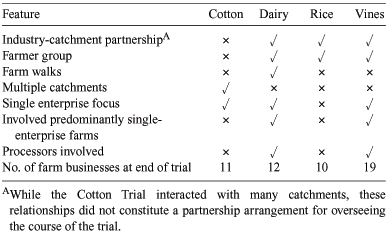
|
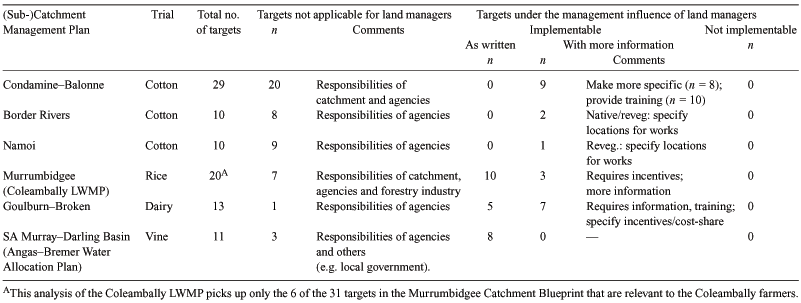
|
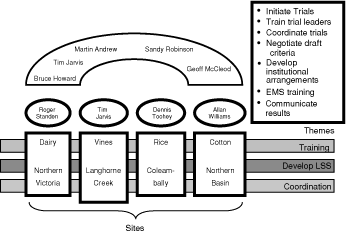
|
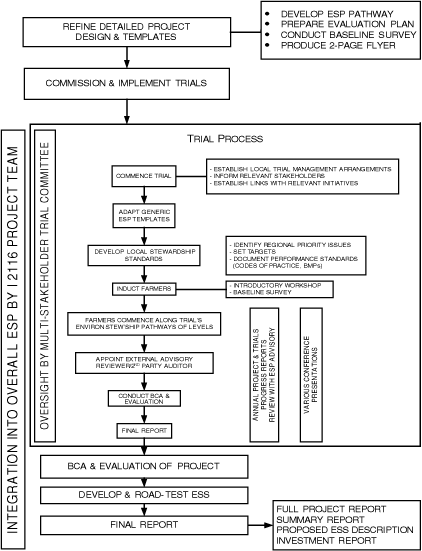
|
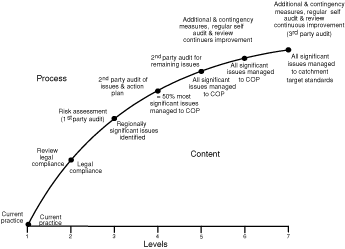
|


